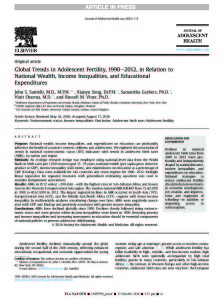Global Declines in Adolescent Childbearing related to National Income, Income Inequalities, and Expenditures on Education
- The median adolescent birth rate among nations dropped by 40% from 1990 to 2012
- Largest declines in South Asia – 70%, and Europe/Central Asia – 63%
 Commissioner leads, Dr John Santelli and Prof Russell Viner, in their newly published article, Global Trends in Adolescent Fertility, 1990-2012, in Relation to National Wealth, Income Inequalities, and Educational Expenditures, have found that declines in global adolescent birth rates were profoundly and independently shaped by national income, income inequalities, and expenditures on education. Results are published online in the Journal of Adolescent Health.
Commissioner leads, Dr John Santelli and Prof Russell Viner, in their newly published article, Global Trends in Adolescent Fertility, 1990-2012, in Relation to National Wealth, Income Inequalities, and Educational Expenditures, have found that declines in global adolescent birth rates were profoundly and independently shaped by national income, income inequalities, and expenditures on education. Results are published online in the Journal of Adolescent Health.
The results from this study are the most comprehensive to date of these social determinants and their relationship to trends in global adolescent childbearing. It adds support to the growing body of evidence that suggests narrowing income inequality and increasing education opportunities can (and will) improve the health and wellbeing for adolescents and young adults.
Using data from the World Bank, the researchers examined the national income (per capita GDP), income inequality within nations (the Gini Index), and national expenditures on education as a percentage of GDP and their association with adolescent birth rates and rates of decline in adolescent birth rates among 142 nations over the period 1990-2012.
Adolescent birth rates in 2012 varied more than 200-fold among the 142 nations examined. By region, the highest rates were found in Sub- Saharan Africa and the lowest rates were in Europe and Central Asia and other high-income nations. The U.S. still has among the highest rates of adolescent birth among high income countries, despite a decline of 51 percent between 1990 and 2012 — the period of time for this study. Adolescent birth rates were based on the number of births per 1,000 adolescent women (15-19 years). GDP in current U.S. dollars was used as the indicator of wealth.
While inequalities showed little change over time, regions with lower income inequalities had more rapid rates of decline in adolescent birth rates. The largest regional declines over the 22-year time period occurred in South Asia (70 percent), Europe/Central Asia (63 percent), and the Middle East/North Africa (53 percent)—“regions with lower income inequality,” noted Dr. Santelli.
“Reducing poverty and income inequalities and increasing investments in education should be essential components of national policies to prevent adolescent childbearing,” said John Santelli, MD, Chair and Professor of Population and Family Health at Columbia University’s Mailman School of Public Health. Co-authors included Xiaoyu Song and Samantha Garbers from Columbia, Vinit Sharma of the United Nations Population Fund, and Prof Russell Viner of University College London.